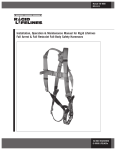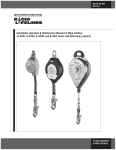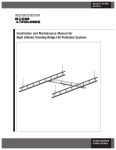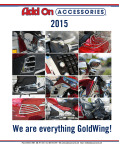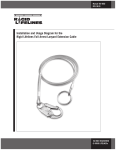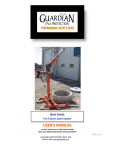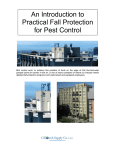Download Evolve™ Full Body Harnesses User Manual
Transcript
User Instruction Manual Rigid Lifelines® Evolve™ Full Body Harnesses Part Numbers: RL-15502D; RL-15503D; RL-15502G-S/M; RL-15502G-L/X; RL-15503G-S/M; RL-15503G-L/X; RL-15502DB-S/M; RL-15502DB-L/X; RL-15502GB-S/M; RL-15502GB-L/X; ISO 9001: 2008 Registered Manual 103-0060 General Safety Information Under Penalty of Law This User Instruction Manual is not to be removed except by the user of this equipment. ■ Current User Instruction Manuals must always be available to the user. ■ Read and understand these instructions before using equipment. ■ Do not throw away these instructions. ■ Misuse or failure to follow warnings and instructions may result in serious personal injury or death. Users must read and understand the User Instruction Manual provided with the product and be properly trained by their employer prior to use per OSHA 29 CFR 1910.66 and 1926.503 or applicable local standards. Compliant fall protection and emergency rescue systems help prevent serious injury during fall arrest. For instructions about proper use, refer to supervisor, User Instruction Manual, or call Rigid Lifelines at: 844-467-4443. Rigid Lifelines® Evolve™ Full Body Harnesses Manual 844-467-4443 2 Purpose Rigid Lifelines® Evolve™ Full Body Harnesses are designed to be used as part of a personal fall arrest, controlled descent, restraint, rescue, or work positioning system. Fall Arrest System Components System Components Overview A complete fall arrest system consists of the following components: Anchorage, Body Support, and Connecting Devices. Note: For continuous protection, more than one system may be needed. Anchorage OSHA 29 CFR 1926.502 states that an anchorage, “Shall be independent of any anchorage being used to support or suspend platforms and capable of supporting at least 5,000 pounds (22.2 kilonewtons) per employee attached, or shall be designed, installed, and used as follows: as part of a complete personal fall arrest system which maintains a safety factor of at least two; and under the supervision of a qualified person.” Body Support A body support is the component of a personal fall arrest system that is worn on or around the body. Per OSHA 29 CFR 1926.502 (effective January 1, 1998), body belts are not acceptable* as part of a personal fall arrest system. Full body harnesses must be used for all fall arrest systems. *Note: The use of a body belt is acceptable in a positioning device system. Connecting Devices A connecting device is the link between the body support and anchorage. Connecting devices will vary depending on the application. 3 Rigid Lifelines® Evolve™ Full Body Harnesses Manual 844-467-4443 Table of Contents General Safety Information Purpose Fall Arrest Components Instructions For Use Limitations For Use Anchorage Requirements Connection Compatibility Limitations Fall Clearance/Clear Fall Charts Swing Fall Attachment Points Donning Materials Accessories Training Inspection Cleaning, Maintenance, and Storage Labeling Inspection Log Service Policy One-Year Equipment Warranty Rigid Lifelines® Evolve™ Full Body Harnesses Manual 844-467-4443 2 3 3 5 6 7 8 9 11 12 13 17 18 19 20 22 23 25 27 Back Cover 4 Instructions For Use Failure to follow all instructions and limitations on the use of this equipment may result in serious personal injury or death. ■ Before using a personal fall arrest system, employees shall be trained in accordance with the requirements of OSHA 29 CFR 1910.66 in the safe use of the system and its components. ■ Prior to each use, inspect all personal fall arrest system equipment for wear, damage, and other deterioration. Defective components must be removed from service immediately in accordance with the requirements of OSHA 29 CFR 1910.66 and 1926.502. ■ After a fall, or if any part of the load indicator warning is showing, the Evolve™ Full Body Harness must be removed from service and destroyed immediately. ■ Thoroughly evaluate and plan all elements of your fall protection system(s) before using your equipment. Make sure that your system is appropriate for your needs and facility. Also be sure to calculate fall clearance and swing fall clearance. ■ Users must have a rescue plan and the means to implement it. This plan must provide prompt employee rescue or assure that employees have the ability to rescue themselves in the event of a fall. ■ Store this equipment in a cool, dry, and clean environment that is out of direct sunlight when not in use. ■ After a fall occurs, this equipment must be removed from service and destroyed immediately. ■ Failure to follow all instructions and limitations on the use of Personal Energy Absorbers and Energy Absorbing Lanyards may result in serious personal injury or death. ■ Failure to have the leg straps of the Evolve Full Body Harness properly adjusted in the event of a fall arrest may result in serious personal injury or death. ■ Never attach the unused leg of the lanyard back to the Evolve Full Body Harness anywhere other than an approved lanyard storage keeper. ■ To minimize the potential for accidental disengagement, a Competent Person must ensure system compatibility. ■ All equipment must be inspected before each use according to the instructions found in this User Instruction Manual. All equipment should be inspected by a qualified person on a regular basis. ■ Never use fall protection equipment for purposes other than those for which it was designed. ■ Environmental hazards should be considered when selecting fall protection equipment. ■ Do not expose the equipment to any hazard which it is not designed to withstand. Consult Rigid Lifelines in cases of doubt. ■ Never remove product labels because they include important warnings and information for the Authorized Person/User. ■ 5 Rigid Lifelines® Evolve™ Full Body Harnesses Manual 844-467-4443 Limitations For Use This equipment is designed to be used in temperatures ranging from -40ºF to +130ºF (-40°C to +54°C). ■ Do not expose this equipment to chemicals or harsh solutions that may have a harmful effect. Contact Rigid Lifelines with any questions. ■ Use caution when working with this product near moving machinery, electrical hazards, sharp edges, or abrasive surfaces, as contact may cause equipment failure, personal injury, or death. ■ Minors, pregnant women, and anyone with a history of back and/or neck problems should not use this equipment. ■ Do not use or install equipment without proper training from a “Competent Person,” as defined by OSHA 29 CFR 1926.32(f). ■ Only Rigid Lifelines, or entities authorized in writing by Rigid Lifelines, shall make repairs or alterations to the equipment. ■ Evolve™ Full Body Harnesses are designed for users with a maximum capacity up to 310 lb.* (141 kg.) including clothing, tools, etc. *If the system is used by an employee having a combined tool and body weight between 310 lb. (140.6 kg.) and 400 lb. (181.4 kg.), then the employer must appropriately modify the criteria and protocols to provide proper protection for such heavier weights, or the system will not be deemed to be in compliance with the requirements of OSHA 1926.502(d) (16). [ANSI capacity range is 130 lb. – 310 lb. (59 kg. – 140.6 kg.).] ■ Personal Energy Absorbers and Energy Absorbing Lanyards marked with, “ANSI Z359.13,” and “6 ft. Free Fall” are designed for up to 6 ft. free fall applications with a maximum capacity up to 310 lb. (141 kg) including clothing, tools, etc. ■ Evolve Full Body Harnesses shall be used as part of a personal fall arrest system that limits the maximum free fall distance to 6 ft. (1.8 m). If used with appropriate connecting system, Evolve Full Body Harnesses may be used with free falls exceeding 6 ft. (1.8 m). ■ Full Body Harnesses shall only be used as part of a controlled descent or rescue system that eliminates free fall unless attached to the dorsal D-ring. When attached to the dorsal D-ring, the maximum free fall distance is 6 ft. (1.8 m). ■ Full Body Harnesses shall only be used as part of a work positioning system that limits the maximum free fall distance to 2 ft. (0.6 m). ■ Only use components rated for the same weight capacity. Not all fall protection components are rated for the same user weight capacity. ■ Proper precautions should always be taken to remove any obstructions, debris, material, or other recognized hazards from the work area that could cause injuries or interfere with the effective operation of the system. ■ Do not use fall protection equipment for towing or hoisting. ■ Protect all synthetic material from slag, hot sparks, open flames, or other heat sources. ■ Rigid Lifelines® Evolve™ Full Body Harnesses Manual 844-467-4443 6 Do not expose equipment to environmental hazards and chemicals which may produce a harmful effect. Polyester should be used in certain chemical or acidic environments. ■ Do not allow equipment to come in contact with anything that will damage it including (but not limited to): sharp edges, abrasive surfaces, moving machinery, or high-temperature applications like welding, heat sources, and electrical areas. ■ Evaluate space below work area to ensure potential fall path is clear of obstructions. ■ Allow adequate fall clearance below the work surface. Consult chart on page 9. ■ Anchorage Requirements All anchorages to which the Personal Energy Absorbers and Energy Absorbing Lanyards attach must meet the requirements of OSHA 29 CFR 1910.66 and ANSI Z359.1-2007. OSHA states: Anchorages to which personal fall arrest equipment is attached shall be capable of supporting at least 5,000 lb. (22.2 kN) per employee attached, or shall be designed, installed, and used as part of a complete personal fall arrest system which maintains a safety factor of at least two, under the supervision of a qualified person. ANSI Z359.1-2007 states that anchorages in a personal fall arrest system must have strength capable of sustaining static loads applied in all directions permitted by the system of at least: (a) Two times the maximum arrest force permitted on the system with certification, or (b) 5,000 lb. (22.2 kN) in the absence of certification When more than one personal fall arrest system is attached to the anchorage, the strength in (a) and (b) must be multiplied by the number of personal fall arrest systems attached to the anchorage. Anchorages used in controlled descent and rescue systems must be capable of supporting loads of 3,100 ft-lb. (13.8 kN) for non-certified anchorages or a 5:1 safety factor for certified anchorages per ANSI Z359.4-2007. Anchorages used in restraint systems must be capable of supporting loads of 1,000 ft-lb. (4.5 kN) for non-certified anchorages or two times the foreseeable force for certified anchorages per ANSI Z359.2-2007. Anchorages used in work positioning systems must be capable of supporting loads of 3,000 ft-lb. (13.3 kN) for non-certified anchorages or two times the foreseeable force for certified anchorages per ANSI Z359.2-2007. Anchorages should be located as vertically as possible above the user’s head and be positioned as not to exceed the maximum allowable free fall for the system. 7 Rigid Lifelines® Evolve™ Full Body Harnesses Manual 844-467-4443 Connection Compatibility Limitations All Rigid Lifelines® equipment must be coupled to compatible connectors. OSHA 29 CFR 1926.502 prohibits snap hooks from being engaged to certain objects unless two requirements are met: 1. It must be a locking type snap hook. 2. It must be “designed for” making such a connection. a. “Designed for” means that the manufacturer of the snap hook specifically created the snap hook to be used to connect to the equipment in question. The following conditions can result in rollout* when a non-locking snap hook is used. Avoid the following connections: ■ ■ ■ ■ ■ ■ Direct connection of a snap hook to horizontal lifeline. Two (or more) snap hooks connected to one D-ring. Two snap hooks connected to each other. A snap hook connected back on its integral lanyard. A snap hook connected to a webbing loop or webbing lanyard. Improper dimensions of the D-ring, rebar, or other connection point in relation to the snap hook dimensions that would allow the snap hook keeper to be depressed by a turning motion of the snap hook. * Rollout: A process by which a snap hook or carabiner unintentionally disengages from another connector or object to which it is coupled. (ANSI Z359.0-2007) Rigid Lifelines® Evolve™ Full Body Harnesses Manual 844-467-4443 8 Fall Clearance/Clear Fall Charts Clearance Requirements These illustrations are an example of how to calculate fall clearance when using a self-retracting lanyard or a shock-absorbing lanyard. Image 1 shows a self-retracting lanyard anchored overhead with the other end connected to the dorsal D-ring of a full body harness. When positioning a selfretracting lanyard, include the following distances in your calculations: Using the Rigid Lifelines® Defy™ Self-Retracting Lanyard will require a total fall clearance of approximately 7.5 feet (2.3 meters) as measured from the working level to the nearest obstruction below. The total fall clearance combines the sum of the maximum allowable fall arrest distance of 54 inches or 4.5 feet (1.4 meters) and the safety factor of 3 feet (0.9 meters). 9 Rigid Lifelines® Evolve™ Full Body Harnesses Manual 844-467-4443 Image 2 shows a shock-absorbing lanyard anchored overhead with the other end connected to the dorsal D-ring of a full body harness. Note that the length of your shock-absorbing lanyard in relation to where it is attached is directly related to the amount of fall clearance that you will need. When using a shock-absorbing lanyard, include the following distances in your calculations: Using the 6 Foot Rigid Lifelines® Connex™ Shock-Absorbing Lanyard will require a total fall clearance of approximately 18 feet (5.5 meters) as measured from the anchorage point of lanyard to the nearest obstruction below. The total fall clearance combines the sum of the length of the lanyard, the maximum elongation of the lanyard (4 feet or 1.2 meters), the average distance between the worker’s dorsal D-ring (5 feet or 1.5 meters), and the safety factor (3 feet or 0.9 meters). Using an extended free fall (12 foot) Connex Shock Absorbing Lanyard will require a total fall clearance of approximately 20 feet (6.1 meters) when anchored at foot level and measured from the anchorage point of lanyard to the nearest obstruction below. The total fall clearance combines the sum of the length of the lanyard, free fall distance, the maximum elongation of the lanyard (5 feet or 1.5 meters), the average distance between the worker’s dorsal D-ring, (5 feet or 1.5 meters), and the safety factor (3 feet or 0.9 meters). Rigid Lifelines® Evolve™ Full Body Harnesses Manual 844-467-4443 10 Swing Fall To minimize the possibility of a swing fall, work as directly under the anchorage connector as possible. Striking objects horizontally, due to the pendulum effect, may cause serious injury. Swing falls also increase the vertical fall distance of a worker, compared to a fall directly below the anchorage connector. Swing falls may be reduced by using overhead anchorage connectors that move with the worker. Workers accessing areas greater than 30° off-plumb from overhead anchorage are at a higher risk for severe injury. Striking objects horizontally due to the pendulum effect of a swing fall may cause serious injury or death. 11 Rigid Lifelines® Evolve™ Full Body Harnesses Manual 844-467-4443 Attachment Points The dorsal (back) D-ring affixed to all Rigid Lifelines® Evolve™ Full Body Harnesses is for fall arrest or restraint systems. The dorsal D-ring may also be used for rescue applications. Hip D-rings are used for positioning and restraint systems. Always use both hip D-ring connections when securing work positioning devices. Hip D-rings are not for fall arrest or climbing applications. Rigid Lifelines® Evolve™ Full Body Harnesses Manual 844-467-4443 12 Donning Not all fall protection components are rated for the same user weight capacity. Only use components rated for the same weight capacity. There must be a functional rescue plan if users of fall protection systems cannot rescue themselves. Note: Sewn terminations should be secure, complete, and not visibly damaged. No load indicators shall be deployed. Damaged and other deteriorated and defective components must be immediately removed from service in accordance with the requirements of OSHA 29 CFR 1910.66 and 1926.502. Fitting an Evolve™ Full Body Harness 1. Hold the dorsal (back) D-ring of the harness and shake to allow all straps to fall into place. Straps must not be buckled or twisted. 13 Rigid Lifelines® Evolve™ Full Body Harnesses Manual 844-467-4443 2. Slip shoulder strap over one shoulder, then pull the other shoulder strap around the back and over the second shoulder — much like putting on a jacket. The dorsal D-ring will be located on your back while the chest strap is located in the front. Straps must not be tangled as the harness hangs freely from shoulders. 3. Pull one leg strap between your legs and connect it to the opposite end on the same side. Repeat with second leg strap. Ensure that the leg straps are not twisted or crossed. Leg straps must be comfortably snug to achieve proper adjustment. Rigid Lifelines® Evolve™ Full Body Harnesses Manual 844-467-4443 14 Failure to have the leg straps of the Evolve™ Full Body Harness properly adjusted during fall arrest may result in serious personal injury or death. 15 Rigid Lifelines® Evolve™ Full Body Harnesses Manual 844-467-4443 4. Fasten the chest strap just above the nipple line. Chest strap should be snug with excess strap-length secured through the web keepers. 5. Adjust shoulder straps* with the two adjusters located at the lower end of the shoulder strap. Adjust the left and right sides to the same length. The chest strap (and front D- ring, if applicable) must be centered on your lower chest. Rigid Lifelines® Evolve™ Full Body Harnesses Manual 844-467-4443 16 *Adjustment of the shoulder straps may cause the dorsal D-ring to move and may need to be repositioned up or down as needed to achieve correct position. 6. After all straps have been tightened and harness fits snugly, secure all excess straps through the web keepers. Materials Webbing All Rigid Lifelines® Evolve™ Full Body Harnesses are constructed with 1.75 in. (44 mm) polyester webbing. Hardware All hardware on the Evolve Full Body Harness meets the ANSI Z359.1-2007 standard and OSHA 29 CFR 1910.66 and 1926.502 requirements. 17 Rigid Lifelines® Evolve™ Full Body Harnesses Manual 844-467-4443 Accessories Rigid Lifelines Suspension Trauma Relief Pack The Rigid Lifelines® Suspension Trauma Relief Pack (RL-TRP) is available for use on all Rigid Lifelines Evolve™ Full Body Harnesses. The Suspension Trauma Relief Pack must be choked onto the vertical torso straps of the harness, located above the primary connection opening of the hip joint. Refer to the Suspension Trauma Relief Pack User Instructions for more information. Lanyard Storage Keepers Approved lanyard storage keepers are located on all Rigid Lifelines Evolve Full Body Harnesses where the shoulder strap meets the chest strap. Lanyard storage keepers are only approved for the connection of the unused lanyard length to the harness. Rigid Lifelines® Evolve™ Full Body Harnesses Manual 844-467-4443 18 Never attach the unused length of the lanyard back to the Evolve™ Full Body Harness at any location other than an approved lanyard storage keeper. Training Employers are responsible for providing training to any employee who may be exposed to fall hazards. Training will enable an employee to recognize and reduce fall hazards. Training must be conducted by a Competent or Qualified Person. Trainer and trainees must not be exposed to fall hazards during the training course. 19 Rigid Lifelines® Evolve™ Full Body Harnesses Manual 844-467-4443 Inspection Frequency Evolve™ Full Body Harnesses must be inspected prior to each use and annually by an OSHA defined “Competent Person” other than the user. After a fall occurs, or if any part of the load indicator warning (located on webbing below dorsal D-ring pad) is showing, the Evolve Full Body Harness must be removed from service. If inspection reveals any defect, inadequate maintenance, or unsafe condition, remove from service immediately. Any harness with noticeable wear or damage must be removed from service immediately. Contact Rigid Lifelines for help with replacement. Any equipment that has been subjected to the forces of arresting a fall must be removed from service immediately. Note: Only manufacturer, or entities authorized in writing by the manufacturer, may make repairs to the product. Otherwise, equipment must not be altered in any way. All components of the Evolve Full Body Harness must be inspected. Inspect labels for presence and legibility. Rigid Lifelines® Evolve™ Full Body Harnesses Manual 844-467-4443 20 To Inspect Webbing Bend a portion of the webbing 6-8 in. (15-20 cm) into an upside-down ‘U’ shape. Continue along all webbing inspecting for tears, cuts, fraying, abrasion, discoloration, burns, holes, mold, pulled or broken stitches, or other signs of wear and damage. Adjust all keepers, buckles, padding, and D-ring to inspect webbing hidden by these components. Sewn terminations must be secure, complete, and not visibly damaged. Check all buckles for damage, distortion, cracks, breaks, and rough or sharp edges. Inspect for any unusual wear, frayed or cut fibers, or broken stitching of the buckle attachments. Make sure buckles properly engage. Tongue buckle/grommet tongues should be free of distortion in shape and motion. They should overlap the buckle frame and move freely back and forth in their socket. The roller should turn freely on frame. Inspect for loose, distorted, or broken grommets. Webbing should not have additional punched holes. 21 Rigid Lifelines® Evolve™ Full Body Harnesses Manual 844-467-4443 The outer bars and center bars on friction and slotted mating buckles must be straight. Ensure that the Quick-Connect buckle’s dual-tab release mechanism is free of debris and engages properly. Double-check the buckle locking mechanism by tugging on both halves of the buckle to make sure it is firmly connected and will not disengage. All markings must be legible and attached to the product. All hardware must be free of cracks, sharp edges, deformation, corrosion, or any evidence of defect. Cleaning, Maintenance, and Storage CAUTION Wear proper Personal Protective Equipment when performing Inspection, Cleaning, and Maintenance procedures. Safety glasses and gloves are recommended. Cleaning Rigid Lifelines® Evolve™ Full Body Harnesses can be wiped down with a mild detergent and rinsed with a clean cloth to remove detergent. The hardware can also be wiped down with a clean, dry cloth to remove grease or dirt. Maintenance Any Rigid Lifelines Evolve Full Body Harness requiring maintenance must be tagged “unusable” and removed from service. Only Rigid Lifelines, or persons or entities authorized in writing by Rigid Lifelines, shall make repairs or alterations to the equipment. Cleaning and maintenance may be performed by the user. Rigid Lifelines® Evolve™ Full Body Harnesses Manual 844-467-4443 22 Storage ■ ■ ■ ■ When not in use, Rigid Lifelines® Evolve™ Full Body Harnesses should be stored in a cool, dry place out of direct sunlight. Do not store in areas where damage from environmental factors such as heat, light, excessive moisture, oil, chemicals and their vapors, or other degrading elements may be present. Do not store damaged equipment or equipment in need of maintenance in the same area as product approved for use. Equipment must be cleaned and dried prior to storage. Equipment that has been stored for an extended period must be inspected as described in these User Instructions prior to use. Labeling All labeling must be legible and attached to the full body harness. Evolve™ logo Evolve™ Warning Label Evolve™ Fall Indicator 23 Rigid Lifelines® Evolve™ Full Body Harnesses Manual 844-467-4443 Evolve™ Long Label Rigid Lifelines® Evolve™ Full Body Harnesses Manual 844-467-4443 24 Inspection Log Notes If equipment fails inspection IMMEDIATELY REMOVE FROM SERVICE. User must inspect prior to EACH use. Competent Person other than user must complete formal inspection at least every 6 months. Competent Person to inspect and initial. Date of first use: ________________. Product lifetime is 5 years as long as it passes pre-use and Competent Person inspections. REMOVE FROM SERVICE 5 years after date of first use, or, if not recorded, from date of manufacture. This inspection log must be specific to one Internal Shock Lanyard. Separate inspection logs must be used for each Internal Shock Lanyard. All inspection records must be made visible and available to all users at all times. Sample 5-Year Inspection Grid YR J F M A M J 25 J A S O N D Rigid Lifelines® Evolve™ Full Body Harnesses Manual 844-467-4443 Notes ________________________________________________ ________________________________________________ ________________________________________________ ________________________________________________ ________________________________________________ ________________________________________________ ________________________________________________ ________________________________________________ ________________________________________________ ________________________________________________ ________________________________________________ ________________________________________________ ________________________________________________ ________________________________________________ ________________________________________________ ________________________________________________ ________________________________________________ ________________________________________________ ________________________________________________ ________________________________________________ ________________________________________________ Rigid Lifelines® Evolve™ Full Body Harnesses Manual 844-467-4443 26 Service Policy 1. Obtain as much information as possible concerning the problem through personal observation by yourself or other authorized personnel familiar with the job and equipment: include model, serial and/or part numbers, voltages, speeds, and any other special identifying features. Be prepared to discuss the situation in detail. 2. All authorized labor charges will be based on straight time. Hourly rates, estimated man hours, and not to exceed total dollar amount required for corrections are to be agreed upon before authorization is given. There will be no allowances for overtime except in dire emergencies and then only with prior approval. 3. A verbal agreement may be reached immediately on both the method of correction and the approximate cost. A warranty authorization number will be assigned for the specific incident. A confirming written authorization will be forwarded to the distributor. 4. The distributor must send an itemized invoice, showing our release number or invoice number and warranty authorization number after authorized corrections have been made. A credit memo will be issued by accounting after the invoice has been received and approved. Warranty charges ARE NOT to be deducted from outstanding open account invoices under any circumstances. 5. Any field corrections made prior to an authorization by Rigid Lifelines will not be accepted as a warranty charge or the responsibility of Rigid Lifelines. Any modification to the equipment made without prior approval of the seller will void all warranties. A verbal authorization for modification may be obtained, in which event a warranty authorization number will be assigned for the specific modification. A confirming written authorization will be forwarded to the distributor. 27 Rigid Lifelines® Evolve™ Full Body Harnesses Manual 844-467-4443 One-Year Equipment Warranty Rigid Lifelines warrants all Rigid Lifelines® fall protection soft goods, devices, connectors, and accessories to be free from defects in material and workmanship for a period of one (1) year, commencing on the date of shipment to the first retail purchaser (“Purchaser”). Rigid Lifelines is dedicated to offering superior service and quality products to all of our customers. If you would like to contact a customer service representative, please call the following number: 1 (844) 467-4443. We will be happy to assist you in any way that we can. These warranties do not extend to equipment which has been subject to misuse, use in excess of rated capacity, negligent operation, use beyond Rigid Lifelines published service factors, improper installation or maintenance, adverse environments, and does not apply to any equipment which has been repaired or altered without Rigid Lifelines written authorization. This warranty is void for any product that is designed to deform or absorb energy during a fall event and needs to be replaced after a fall event has occurred. Written notice of any claimed defect must be given to Rigid Lifelines within thirty (30) days after such defect is discovered. Rigid Lifelines obligation, and Purchaser’s sole remedy under this warranty is limited to, at Rigid Lifelines discretion, the replacement or repair of the equipment at Rigid Lifelines factory or at a location approved by Rigid Lifelines. THIS WARRANTY IS EXPRESSLY IN LIEU OF ALL OTHER WARRANTIES WHATSOEVER WHETHER EXPRESS, IMPLIED, OR STATUTORY. SELLER MAKES NO WARRANTY AS TO THE MERCHANTABILITY OR FITNESS FOR A PARTICULAR PURPOSE OF THE EQUIPMENT AND MAKES NO OTHER WARRANTY, EITHER EXPRESS OR IMPLIED. Rigid Lifelines shall not be liable, under any circumstances, for any indirect, special, or consequential damages including (but not limited to): lost profits, increased operating costs, or loss of production. This warranty shall not extend to damages including (but not limited to): lost profits, increased operating costs, or loss of production. This warranty shall not extend to any components or accessories not manufactured by Rigid Lifelines (example: casters), with the exception of the components, systems, or accessories involved with XSPlatforms, and purchaser’s remedy for such components and accessories shall be determined by the terms and conditions of any warranty provided by the manufacturer of such components and accessories. Rigid Lifelines 730 Hemlock Road, Suite 104 Morgantown, PA 19543 Toll Free: (844) 467-4443 Local: (610) 286-8030 Fax: (610) 286-6408 RigidLifelines.com [email protected] ©2014. All rights reserved. Specifications subject to change without prior notice. RLL-EFBH0114V1




























